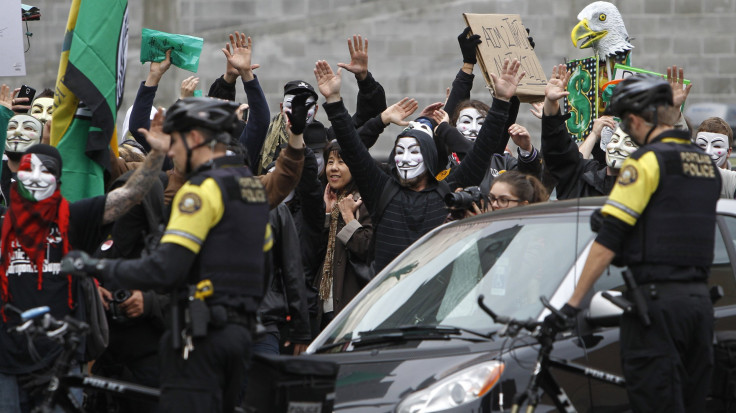Anonymous Hackers Threaten Canadian Police, Alleging 'Swatting' Suspect Was Framed

Members of the Anonymous hacking collective have taken responsibility for knocking a number of official Canadian websites offline in retaliation for what they say was the wrongful arrest of an Ottawa teenager. The hack, which targeted city police departments and the Supreme Court of Canada, began Friday but continued into Monday, with hackers threatening to release stolen information Tuesday.
The first websites to be infiltrated belonged to the Ottawa Police Department and the Ottawa City government, which displayed the name of an Ottawa police officer who was involved in the investigation of an unnamed teenager. That 16-year-old, whose case is pending, was accused earlier this year of phoning at least 30 police agencies around North America to report hostage situations and other serious emergencies. The prank, known as “swatting,” aims to trick police into deploying an armed SWAT team to an innocent target’s residence.
Anonymous -- the loosely organized hacker movement that involves itself in controversial legal and political situations -- confirmed its involvement Sunday with a PasteBin statement announcing #OpSoaringEagle.
“The attacks on OttawaPolice.ca, Ottawa.ca, Toronto.ca/TorontoPolice.on.ca, Parl.gc.ca and more are in pure retaliation for the crimes they have committed,” Anonymous wrote. “The police have framed an innocent youth, and failed to investigate the crimes and furthermore, they have failed to provide any shred of solid proof.”
Most sites were restored through the weekend, though the Ottawa Police Service - - which was decorated with an officer’s name and a dancing banana cartoon - - remained offline through press time Monday. Twitter user @AerithTOR (since suspended) claimed responsibility for the distributed denial of service (DDoS) attack, which takes a site offline by overwhelming it with falsified Internet traffic.
Gabriella Coleman, a professor at McGill University in Montreal and author of “Hacker, Hoaxer, Whistleblower, Spy,” a history of Anonymous, told the Ottawa Sun there are small established groups within Anonymous and that #OpSoaringEagle “is very classic Anonymous.”
The father of the accused teenager said Anonymous has been in touch with him, with unnamed members of the collective purporting to have found documents that prove he is innocent. The family’s lawyer told the Ottawa Citizen he hasn’t had the opportunity to review the legitimacy of the documents, though a quote from the father made it clear his hopes are up.
“Think of it this way: There’s a 1,000-piece jigsaw puzzle that has been thrown on a table,” he told the Citizen of the evidence against his son. “You have no picture of what the jigsaw will ultimately look like, but you have this little piece with an alias, and this piece with a website and this piece with a domain registration.”
Less circumspect was investigative journalist and cybersecurity expert Brian Krebs, who wrote in Krebs On Security earlier this year that he has been swatted twice in his career, the victim of a prank that not only endangers police and the public, but can also cost $10,000 per incident.
“Most of the people involved in swatting and making bomb threats are young males under the age of 18 – the age when kids seem to have little appreciation for or care about the seriousness of their actions,” Krebs wrote before elaborating later:
“In nearly every case I’m aware of, these kids who think swatting is fun have serious problems at home, if indeed they have any meaningful parental oversight in their lives. It’s sad because with a bit of guidance and the right environment, some of these kids probably would make very good security professionals.”
© Copyright IBTimes 2024. All rights reserved.











